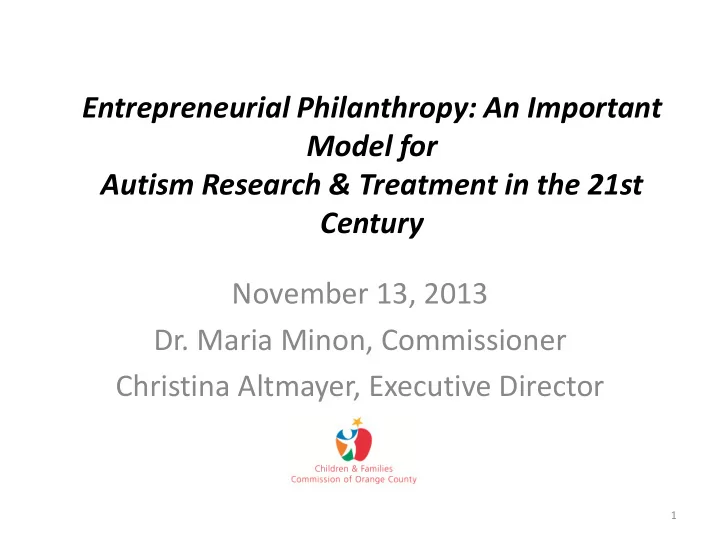

Entrepreneurial Philanthropy: An Important Model for Autism Research & Treatment in the 21st Century November 13, 2013 Dr. Maria Minon, Commissioner Christina Altmayer, Executive Director 1
Children and Families Commission of Orange County • Created through the passage of Proposition 10, November 1998 • Vision “Every child is healthy and ready to learn” • Commission has been partnering with UCI through funding of For OCKids since 2000 – Goal to create a “Center of Excellence” in Southern California that is focused on early assessment, diagnosis, treatment, parent support and research • Commission’s one -time catalytic funding and partnership with Thompson Family Foundation made this possible 2
Demographics California Southern Orange County California Children 0-5 3,036,508 1,748,720 231,218 % of CA population 8.2% 8.1% 7.7% 6,834,403 School Aged Children 4,034,383 551,924 18.3% % of CA Population 18.7% 18.3% 71,825 47,289 Children in Special 8,609 10.5% 11.5% Education with Autism 16.7% *Based on rate of 1:88 or 11.3 per 1000. Sources: Census 2010, Kidsdata from California Dept. of Education, Special Education Division; Assessment, Evaluation and Support (Oct. 2012). 3
Prevalence of Autism Spectrum Disorder (ASD) • About 1 in 88 children has been identified with an ASD according to estimates from the Center for Disease Control and Prevention’s Autism and Developmental Disabilities Monitoring Network. • ASD’s are almost 5 times more common among boys (1 in 54) than among girls (1 in 252). • Parents how have a child with ASD have a 2 – 18% chance of having a second child who is also affected. • The majority (62%) of children the Autism and Developmental Disabilities Monitoring Network identified as having ASD’s did not have intellectual disability. • Much of the prevalence increase from 2007 to 2011-2012 for school aged children was the result of diagnosis of children with previously unrecognized ASD. 4
California Trends 20.0 18.0 16.0 14.0 Percent 12.0 10.0 8.0 6.0 4.0 2.0 0.0 2002 2003 2004 2005 2006 2007 2008 2009 2010 2011 2012 Although the number of School Aged Children Children 0-5 and Children in Special Education have remained School Aged Children somewhat constant over the last ten years, the percent of Children in Special Education with Children in Special Education Autism has increased substantially - by over Children in Special Education with Autism 238% during the same period of time. 5
Importance on Early Intervention • Research has shown that a diagnosis of autism at age 2 can be reliable, valid, and stable. • More children are being diagnosed at earlier ages – a growing number (18%) of them by age 3. • Studies have shown that parents of children with ASD’s notice a developmental problem before their child’s first birthday. Concerns about vision and hearing were more often reported in the first year, and differences in social, communication, and fine motor skills were evident from 6 months of age. • Children should be screened for ASD during regular well-child doctor visits at 18 and 24 months. • Early intervention for particular symptoms such as speech therapy for language delays often does not need to wait for a formal diagnosis. • A notable treatment approach for people with ASD is called applied behavior analysis (ABA). ABA encourages positive behaviors and discourages negative behaviors in order to improve a variety of skills. The child’s progress is tracked and measured. 6
Economic Costs • Individuals with an ASD had an ASD average medical expenditures that exceeded those without an ASD by $4,110 - $6,200 per year. On average, medical expenditures for individuals with an ASD were 4.1 – 6.2 times greater than for those without an ASD. • In 2005, the average annual medical costs for Medicaid-enrolled children with an ASD were $10,709 per child, which was about six times higher that costs for children without as ASD ($1,812). • In addition to medical costs, intensive behavioral interventions for children with ASD’s cost $40,000 to $60,000 per child per year. 7
Commission Impact • In FY 2012/13 Commission funding in partnership with the Center for Autism – Served 1,083 new and 790 repeat children (1,873 total children) and provided the children with 2943 services. – Worked with 2,125 new and 1,847 repeat parents/family members (3,972 total parents) and provided them with 3,961 services. – Supported 2,375 providers. • Uniquely, this program is available to all families in Orange County 8
Recommend
More recommend